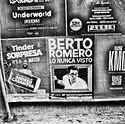Joe Lipka
Member
After talking with Kerik and some other folks at Photolucida last year, I found out my technique was lacking in terms of creating "a convincing black" to someone other than a close relative. From the description of my process, I felt the problem was too much time between coating and exposure. The keen eyes among the group thought my images looked "veiled" and seemed to be somewhat below the surface of the paper. This appealed to my thought that the paper sucked up the sensitizer instead of setting atop the fibers.
The remedy, I thought, was to reduce the time between sensitizing and printing. I tried that this weekend. The paper was Weston Diploma Parchment. An 8 x 10 area was marked off and bombarded with palladium sensitizing solution (18 drops FO, 18 drops Pd and 4 drops of 2.5% NA2), not once fellow hybrid practicitioners, but twice! I coated once, waited until the paper had a damp look and coated it again. When the paper looked damp again, I printed the trusty red green array to find my new blocking color. I exposed, I developed (Pot Ox at 100F). I was convinced the black was black. But, my trusty X-rite 400 disagreed with me.
I found the new blocking color and a DMax of 1.3 to 1.32. Is this as good as it gets with this combination of sensitizer? This is really, really weak as far as blacks go.
Any suggestions?
The remedy, I thought, was to reduce the time between sensitizing and printing. I tried that this weekend. The paper was Weston Diploma Parchment. An 8 x 10 area was marked off and bombarded with palladium sensitizing solution (18 drops FO, 18 drops Pd and 4 drops of 2.5% NA2), not once fellow hybrid practicitioners, but twice! I coated once, waited until the paper had a damp look and coated it again. When the paper looked damp again, I printed the trusty red green array to find my new blocking color. I exposed, I developed (Pot Ox at 100F). I was convinced the black was black. But, my trusty X-rite 400 disagreed with me.
I found the new blocking color and a DMax of 1.3 to 1.32. Is this as good as it gets with this combination of sensitizer? This is really, really weak as far as blacks go.
Any suggestions?






